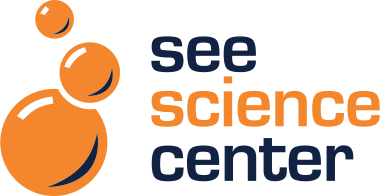Apollo 50th was celebrated at SEE
July 16 -24, NASA’s celebrated the 50th anniversary of the Apollo 11 mission and the organizations plans to return to the moon by 2024 through Artemis missions. The SEE Science Center celebrates the lunar landing everyday through our iconic moonwalk demonstration, which gives young visitors the opportunity to feel what it is like to jump on the moon. During the Apollo 50th anniversary celebration, SEE offered additional opportunities for visitors to be inspired by this amazing accomplishment.
In 1969 the Apollo 11 mission launched on July 16, touched down on the moon on July 20, and returned safely to earth on July 24. During the 50th anniversary of the mission, SEE Summer campers learned about space exploration and built a lunar lander with household materials at SEE. Members of the public were invited to watch and help through social media on July 18 SEE joined NASA and science centers nationwide for a virtual launch. Search #VirtualMoonshot and the SEE Science Center on social media and you’ll see which materials are used, and be able to watch the final design in action. You can also find out how to build your own.
As the anniversary of the moon landing made a final approach, SEE visitors were able to join the celebration in person with a nationwide NASA viewing party (included with admission). The NASA Apollo 50th STEM show was broadcast July 19th from 3 -3:30pm and featured students taking over the new Artemis mission with STEM activities that inspired the next generation of explorers to dream big!
The Apollo 11 astronauts spent twenty-one and a half hours on the moon from July 20 -21 1969. On July 20 & 21 2019 from 1-2pm SEE visitors participated in Family Workshop activities about space travel. Visitors were able to map out the solar system, learn about NASA Artemis missions to return to the moon and visualize their own lunar footprints.
In addition to the activities, the SEE Gift shop featured a “Lift off to Splash Down” sale from July 16 to 24.
At its peak, the Apollo program employed 400,000 people and required the support of over 20,000 industrial firms and universities. SEE continues to work to inspire a new generation of STEM enthusiasts to take on challenges with its exhibits and programs.
